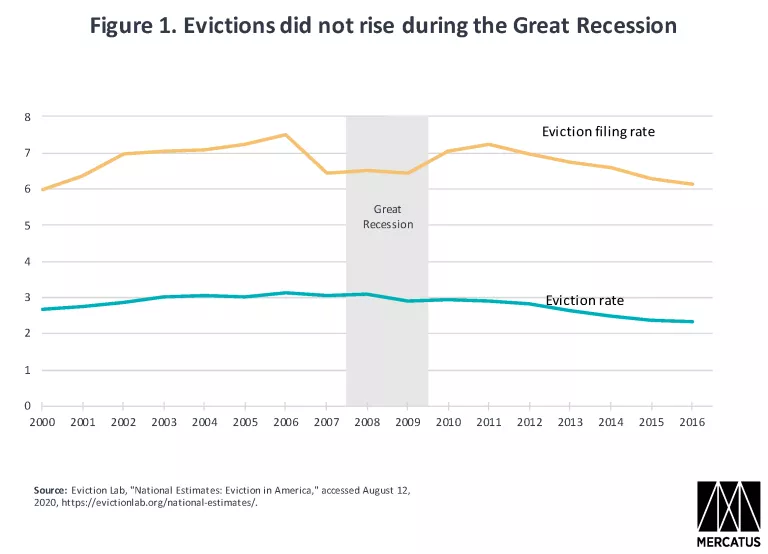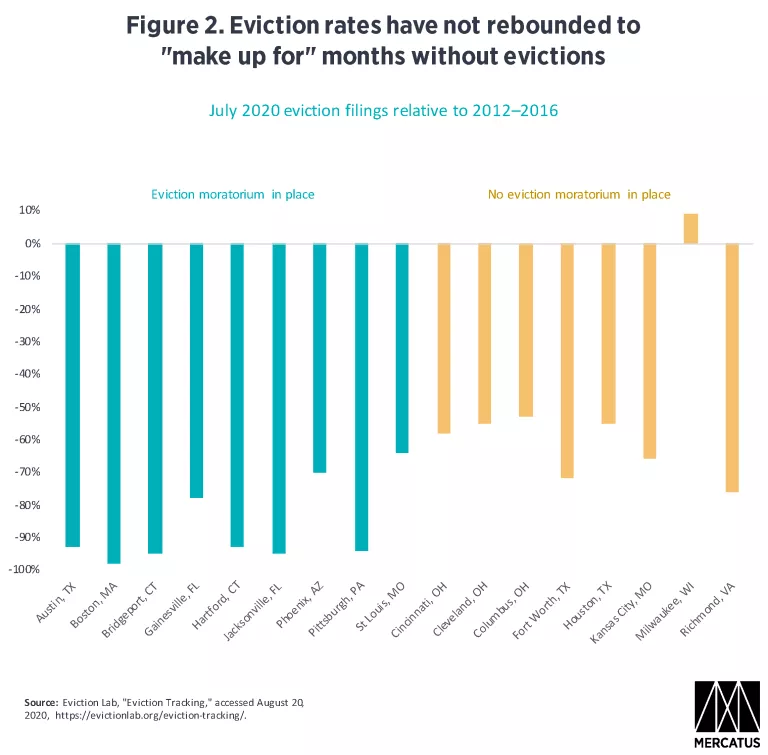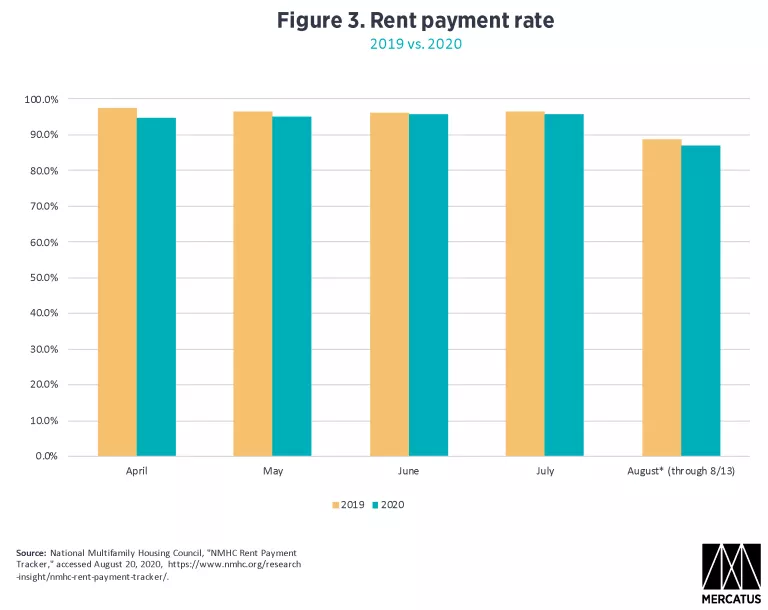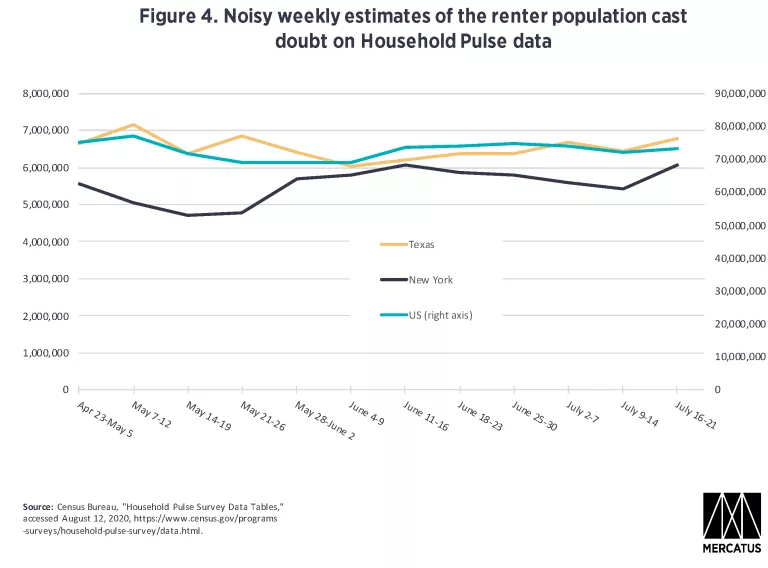- | Expert Commentary Expert Commentary
- |
False Alarm
The popular prediction of an eviction apocalypse is overstated
A growing chorus of rental advocates and journalists warns that US renters face a “tsunami of evictions” unless Congress provides significant rental assistance and a lengthy moratorium on evictions. The evidence so far, however, suggests that evictions for this year will likely remain below 2019 levels.
There’s a reasonable narrative behind the “tsunami” fears: millions have lost jobs and can’t make rent, and the $600-a-week unemployment insurance (UI) bonus ended in late July. Many renters say they will have a hard time making September rent. Thus, a deluge of evictions will follow. To see how this narrative overstates the risk, we need to unpack the available data.
It’s common for renters to miss a month or two of rent; few of those cases result in an eviction. Rather than assuming an adversarial relationship between landlords and tenants, local governments should begin from a belief that both sides are trying, in good faith, to make a mutually beneficial relationship work.
Evictions Did Not Rise during the Great Recession
Matthew Desmond’s profoundly moving book Evicted (2016) sparked the current anti-eviction movement. Now Desmond heads the Eviction Lab at Princeton University, the leading national source of eviction statistics. Eviction Lab’s national data (figure 1) show that eviction rates did not rise during the Great Recession. Puzzling at first, this fact makes sense from the landlord’s perspective. Who was going to replace an evicted tenant? Better, in most cases, to swallow a few months of missed rent and keep a good tenant than to take one’s chances on the market.

Evictions Have Been below Normal Rates since March
Eviction Lab has tracked weekly eviction filings in 17 cities, 9 of which still have local eviction moratoria. As figure 2 shows, July eviction filing rates were far below pre-COVID norms in 16 of the 17 cities. Eviction rates have not risen enough to “make up for” the months of near-zero evictions.

Likewise, statewide data for South Carolina show that evictions have remained at about half the 2019 level since the state’s moratorium was lifted on May 15.
Rent Is Getting Paid
The National Multifamily Housing Council (NMHC), which represents many large landlords, has shared data on rent payment. Two things stand out in figure 3. First, rent payment in 2020 is only slightly below rent payment in 2019. Second, even in 2019, 1 in 30 renters missed rent each month.

The Census Household Pulse Is Not Reliable
Several articles and studies rely on data from an experimental Census Bureau report, the Household Pulse Survey, which purportedly show that some 40 percent of renters are “at risk of eviction” this year. However, the Pulse data are too new and too noisy to interpret reliably. For example, the Pulse cannot reliably estimate, from week to week, the share of Americans who are renters. Figure 4 shows that the renter population vacillates by about 2 million people per week. At the state level, the survey is even noisier. With this much noise, trends are hard to detect.

In addition, the novelty of the survey means we don’t know how to interpret snapshots of the data. With data collected only during the pandemic, there are no normal levels to serve as benchmarks.
But What about September?
Perhaps tenants have been able to make rent only because the bonus UI is paying two-thirds of recipients more than they earned at work. The real test comes, if Washington remains deadlocked, when rent is due on September 1.
Even so, we should remain guardedly optimistic for several reasons:
- In a world before Evicted, the Great Recession passed without any increase in the eviction rate, as shown in figure 1.
- Most renters are paid up going into September, giving them some wiggle room to find an accommodation with landlords.
- The unemployment rate is 10 percent and falling. That’s very high, but it doesn’t logically follow that 40 percent of renters are without income.
- Landlords don’t want to create multiple vacancies in their own buildings. Turnover is costly and takes time.
- If evictions do rise, landlords will become even more wary of going on the market for new tenants, who are likely to have been evicted somewhere else.
If Not Evictions, Then What?
Lots of people miss rent. Few of them get evicted. The rest muddle through. Sometimes they do so by making up back rent—after getting back to work or after paying off another, more urgent, bill. Others find a way to split their unit, bringing in a roommate who can share the rent. An unknown number of renters willingly decamp when they can’t pay the rent—presumably those who have a decent fallback option.
Moratoria Have Costs
Even if the risk of an eviction eruption is low, some advocates will recommend a long moratorium as a precaution. But eviction moratoria are not harmless. Some evictions are important: occasionally, tenants engage in harassment or dangerous behavior that puts their neighbors at risk. A moratorium also fails to distinguish between those who can and can’t pay rent. Given the promise of living rent-free, some tenants, even if they could afford the rent, might take advantage and walk away when the year was out.
Moratoria can also paradoxically cause more evictions because many landlords rely on rental income to make their mortgage and utility payments. Lack of income leads to foreclosure, which leads to the tenants—even paying tenants—getting evicted. One survey found that a quarter of involuntary renter moves in Milwaukee resulted from landlord foreclosures. The bank doesn’t want to be your landlord. An eviction moratorium could backfire by causing foreclosure-induced evictions.
Most importantly, government should not suspend anyone’s contractual rights without a pressing need that cannot otherwise be met. Brief moratoria during the height of the pandemic were defensible on public health grounds; extended, precautionary moratoria go too far.
There Are Light-Touch Solutions
State courts can prevent an eviction avalanche without issuing a blanket moratorium. First, courts should follow Michigan and other states by prioritizing nonfinancial eviction filings. That is, a filing involving harm, property damage, or nuisance moves to the front of the queue, while those involving a single month’s rent go to the very back. Since court time is limited, this policy slow-walks some evictions while moving the most urgent ones through quickly.
Courts, or legislatures, could go further and cap the number of eviction cases on a weekly or monthly basis. Combined with prioritization, this cap would explicitly prevent a flood of cases and would suspend contractual rights only if a severe situation arose. Implicitly, this policy already exists wherever court capacity is limited.
Emphasize Renegotiation
Local governments, unlike Washington, know their own rental markets and are positioned to work with tenants and landlords toward mutually acceptable solutions. In a June policy brief, I outlined several ways that cities can help tenants and landlords muddle through. The easiest step is to publish legally sound lease amendments to formalize and encourage renegotiations.
Policymakers have had little data to guide them so far. As the year turns and more information becomes available, an unprecedented pandemic of evictions may be added to all the other anomalies of this Year of the Asterisk-Shaped Virus. If that happens, attentive policymakers will have time to observe and react.
Photo credit: Charles Gullung/Getty Images